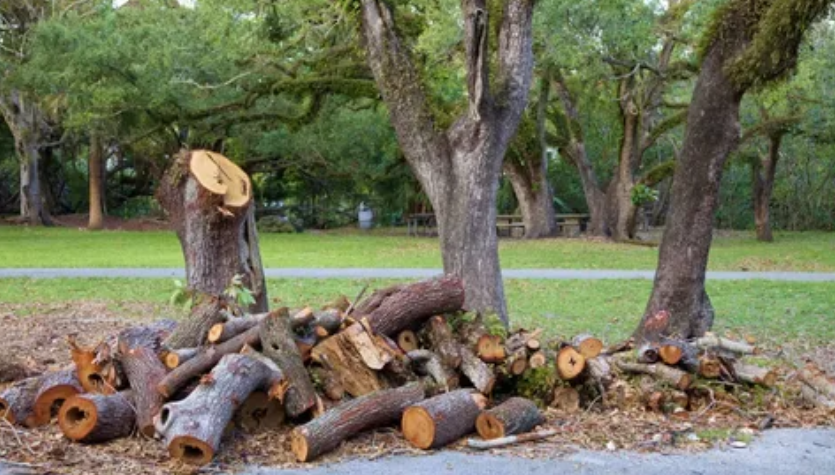
Is ignoring that leaning tree in your backyard really saving you money? You see it every day, drop branches here and there. You might think that it is fine and you will deal with it later, but this approach does not work well. Many property owners hesitate to remove it because of the high upfront costs or its sentimental value. This makes them fail to see the possible property damage or unexpected financial burdens that could occur if the tree’s state lacks care. In this guide, we will explore the hidden risks of tree removal and make you understand why postponing it could be the most expensive mistake.
1. Why Homeowners Delay Tree Removal
Homeowners often postpone tree removal until the tree becomes a clear hazard. By that time removal is often too late. It may seem a way to save money, yet ignoring it can lead to higher costs. Some reasons they avoid removing trees are:
- Removal expenses are considered too high.
- The tree “appears well” (for now) – The presence of leaves does not show that the tree is healthy. Hidden decay disease or a weak root system might cause the tree to collapse.
- Emotional attachment– Trees are a part of our homes. They increase property value and carry memories. Even if the tree is risky, property owners do not remove it.
- It is not a priority – Without a storm or falling branch to compromise safety, removal does not rank high on the list.
- Belief that insurance will pay for damage – This is not a reliable idea. Insurance policies do not cover damage when tree care is neglected.
2. The Financial Risks of Delaying Tree Removal
Waiting is even worse if you are thinking tree removal is quite expensive.
Property Damage Costs
- Roof damage from falling branches: Repairs can cost around $3,000 to even $ 10,000.
- Cracked sidewalks and driveways: This is caused by aggressive root systems. Resurfacing costs range about $1,500 to $5,000.
- Sewer and plumbing damage: Cost about $5,000 to fix the pipes.
- Foundation damage: Roots that expand can compromise a house’s foundation, resulting in repair costs amounting to tens of thousands.
Higher Future Removal Costs
Tree removal becomes more expensive if you wait longer.
- Even if you have a small problem tree, it could turn into a large-scale removal project after a few years.
- Specialized equipment is required for removing dead or rotting trees as they are more fragile. This increases the expenses.
- Prices can be doubled or tripled in case of an emergency tree removal after a storm.
Lower Property Value
A healthy, well-maintained yard helps to increase the market value of properties, whereas a neglected tree does the opposite.
- Tree disease or decay lowers curb appeal.
- Buyers avoid homes with hazardous trees as it signals poor property maintenance.
3. Safety Hazards of Neglected Trees
Overgrown, leaning trees are a dangerous liability and a great financial risk.
Risk to People & Pets
- Serious injury or death can occur because of falling branches.
- Outdoor activities around a weak tree pose a safety hazard to children and pets
- Moreover, sudden tree failure can occur due to storms, strong winds, or heavy snow.
Risk to Structures & Vehicles
- If a tree falls on a house, an individual can face months of costly repairs and cause structural damage.
- Cars parked under unstable trees can be destroyed by falling branches.
Pest & Disease Infestation
If you do not address your dying tree timely, you can spread problems not only to your house but also to your neighborhood.
- Dead trees attract termites, carpenter ants, and rodents. These can invade your home.
- Dutch Elm Disease, Oak Wilt, and Anthracnose are a few examples of tree diseases that can spread to healthy trees nearby.
- Trees can suddenly collapse as fungi and decay create weak spots. Damage from visible decaying of a tree is often too severe to save it.
4. Legal and Insurance Consequences
Insurance companies do not always cover insurance damage.
Liability for Damage & Injury
- Homeowners may be held financially responsible if their tree falls on a neighbor’s house, car, or fence.
- Additionally, you can face a lawsuit if a visitor or a passerby is injured.
Insurance May Deny Your Claim
- Many policies are designed to cover only sudden tree damage (like from a storm).
- Insurance companies refuse to pay if their tree is clearly dying or neglected
- Some policies contain fine print that excludes damage caused by “preventable hazards.”
Fines from HOA & City Regulations
Neglected tree can cause legal trouble too.
- Tree ordinances are required in some areas for the removal of hazardous trees.
- Neglected tree can cause legal trouble too. By ignoring removal orders, homeowners can face fines or forced removal at a higher cost.
5. When Is Tree Removal Urgent?
If you are confused if you need a tree removal right now, go through the listed warning signs. It will help you know when you need a tree removal expert.
Signs of Immediate Danger
- A leaning tree at one side shows your tree is structurally unstable.
- Dead or brittle branches mean the tree is likely dying as the branches snap easily.
- Large cracks in the trunk signal a weak, compromised tree.
- Mushrooms or fungi growing at the base indicate internal rot and decay.
- Hollow trunk or soft wood has a high chance of falling.
Seasonal Risks
- Remove your trees if they are unstable. Especially, before hurricanes, snowstorms, or strong winds hit,
- Opt for a Winter tree removal. It is often cheaper as fewer people schedule tree work in this season.
If you see any of these signs, remove your tree ASAP to prevent damage.
6. Hiring a Professional: What to Look For
Every tree removal company is not the same. There are some licensed experts in some of these companies, whereas some fly-by-night scams are looking to make a quick buck.
How to Find a Reliable Tree Removal Service?
Before opting for a professional service, consider the following:
- Proper licensing & insurance –You could be liable for any accidents if they are not licensed.
- Good reviews & references – Check out recommendations through Google and Yelp.
- Certified arborists on staff – Tree health and safety is valued by a tree professional.
- Written estimates & contracts – Avoid hidden expenses by signing an official contract.
- Safety equipment & experience – Ensure the companies follow industrially established protocols by climbing gear, cranes, and harnesses.
Red Flags to Watch Out For
- Companies that provide no insurance
- Door-to-door offers after a storm. These companies often overcharge and disappear.
- Unmarked trucks or missing business information, making it difficult to verify
- Asking for full payment upfront – Good tree removal experts don’t demand full payment before work is done. They explain the risks after evaluating your tree and offer a fair, transparent price.
Final Thoughts
In short, delaying tree removal may seem easy to save money but in reality it leads to greater expenses, property damage, and safety risks. You can face costly repairs, legal liabilities, or injuries as hazardous trees can fall anytime. If you are looking for a reliable and professional service, contact NYC Discount Tree Experts. We protect your home and loved ones through providing proactive maintenance services. Partner with our arborists today to restore the functionality of your space!

